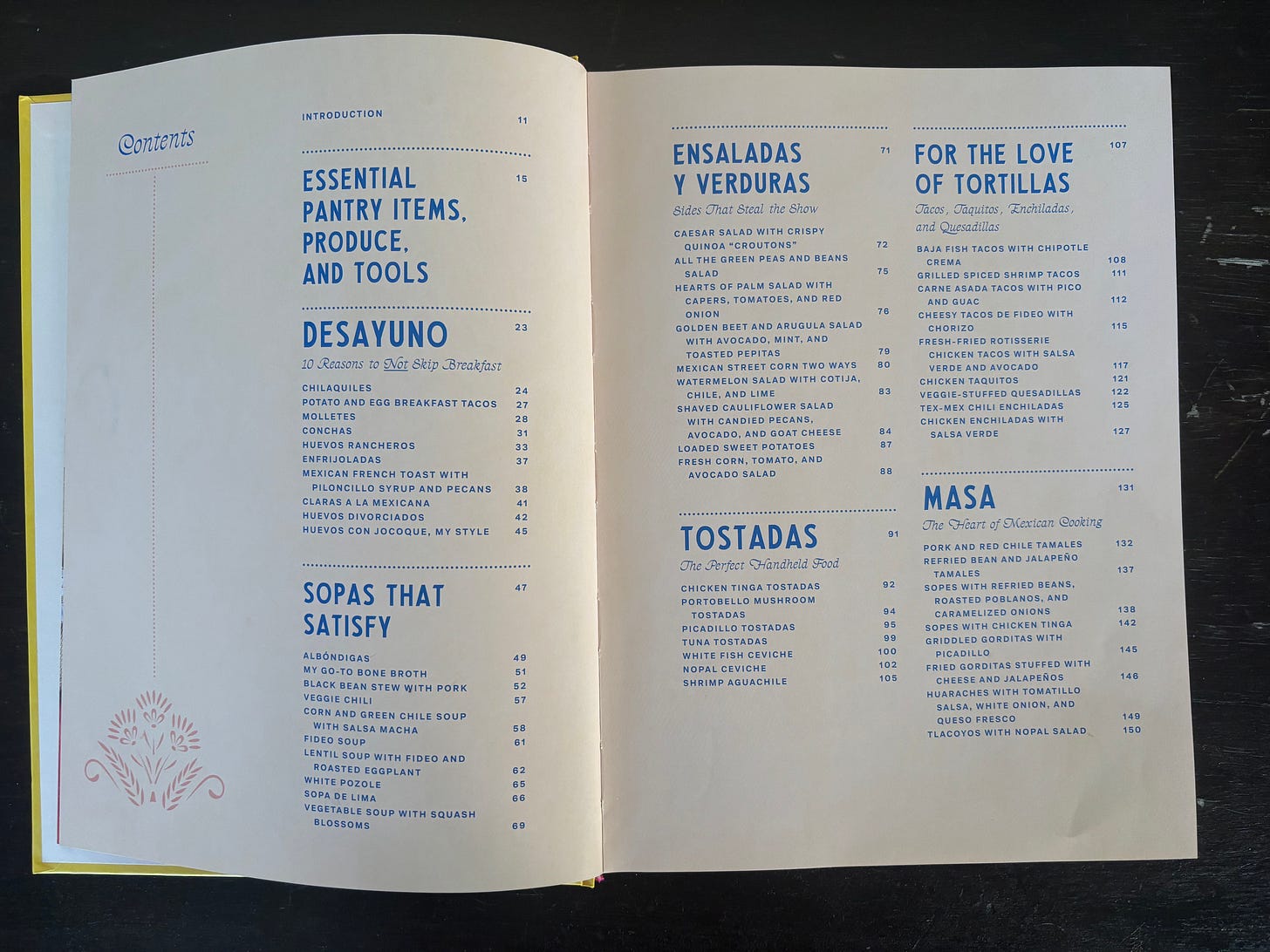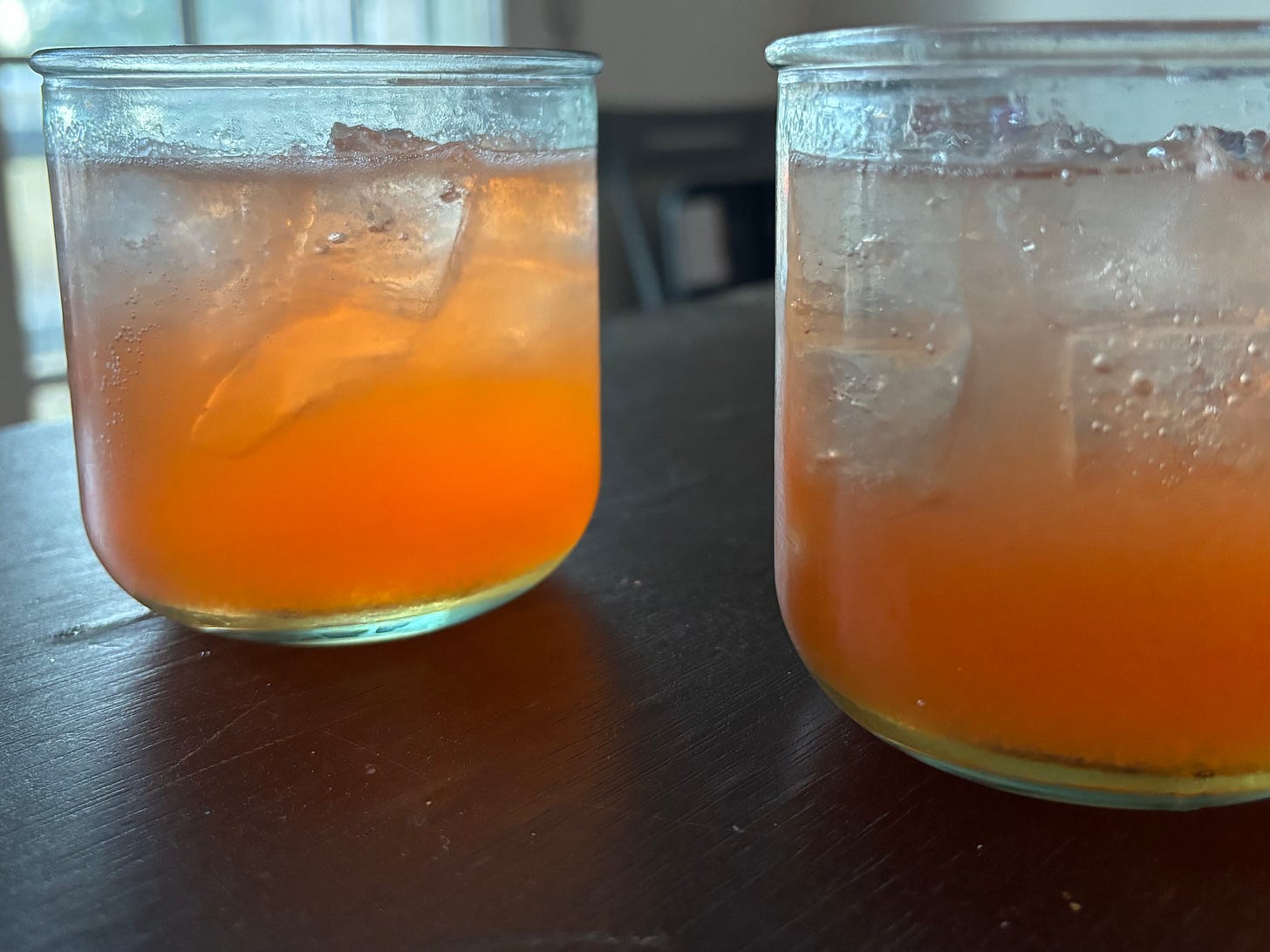Desperate Home Cooks: A Review of My Mexican Kitchen by Eva Longoria
In My New Mexican Kitchen
I will admit that, until recently, the last time I paid close attention to Eva Longoria’s career was maybe, say, 2007, when I still had access to cable TV and paper magazines and people were obsessed with Desperate Housewives.1
Then, this past fall, just as I was embarking on the latest season of Only Murders in the Building—a season in which Longoria was a guest star—her new book, My Mexican Kitchen: 100 Recipes Rich with Tradition, Flavor, and Spice, appeared on my doorstep (or rather, at my PO Box).2
In Only Murders, Longoria, playing an embellished version of herself, lectures one of the main characters on diversifying revenue streams. And, as it turns out, Longoria has been doing this exact thing in real life. Not only does she have a tequila brand, she also has been establishing herself as a food authority.
This pivot isn’t completely unprecedented. You may know (I didn’t) that she released her first cookbook in 2011. Of that book, Longoria states in her introduction to My Mexican Kitchen:
“I so clearly remember telling my editor that, while I planned to include some Mexican dishes, I didn’t want the book to be all Mexican food. I saw my cooking as a reflection of me and, although my Mexican heritage is an essential part of my identity, I didn’t want to be defined solely by it.”
Since then, Longoria has moved to embrace this heritage. She is married to a Mexican man with whom she has a son, and she calls both Los Angeles and Mexico City home.
Apart from these personal credentials, she has also pursued the subject professionally, hosting a CNN culinary documentary, Searching for Mexico, and cohosting a food history podcast, Hungry for History.
The Book
Both of these influences—her home and working life—inform this book. The dishes are a mash up of unique dishes from her travels, staples her family likes to eat, childhood favorites, and some restaurant recreations. Longoria, who grew up in Texas, calls it a “Texican” approach. Overall, it’s largely Mexican, with a bit of Texas and California thrown in.
As such, the recipes themselves are varied. The book has a chapter each on breakfast, soup, sides/salads, tostadas, tortilla-based dishes (tacos, taquitos, enchiladas, quesadillas), masa-based dishes (tamales, sopes, gorditas, huaraches, tlacoyos), main dishes, desserts, drinks, and a final chapter on staples and condiments (tortillas, salsas, beans).
Some are quite simple weeknight dishes, like grilled shrimp tacos, veggie quesadillas, and a picadillo made with frozen mixed vegetables. Others are more complex, such as short rib birria and tamales. There are classic Mexican dishes that you may well have a million recipes for already, like a margarita, chicken tinga, and a tres leches cake. And then there are some deep cuts, like Huevos con Jocoque, a Lebanese-Mexican egg-and-yogurt dish, and Vanilla Chicken, where the poultry is cooked in a cream sauce heavily flavored with Mexican vanilla.
Paging through the book, I was very excited to begin cooking. Living in such a rural area, my access to ingredients beyond basic-American cuisine is pretty constrained. The one exception to that, however, is Mexican ingredients. Owing to the large Mexican-American population around these parts, I could find everything Longoria called for at my local Walmart. The various chiles, Maria cookies, Abuelita chocolate, fideo, cotija, piloncillo, and so on were no issue.
Having lived in places like Appalachia, suburban Ontario, and Washington, DC with only a rundown Giant nearby, I know this access is not a given. If you live in such a place, this book might be a bit tougher to cook from. Longoria gives substitutions where she can, but a good Latin grocer/aisle is definitely your friend if you want to make good use of My Mexican Kitchen.
As one more fun aside, Longoria intersperses the book with historical and culinary facts about Mexican food, which I enjoyed. She delves into the history of vanilla—the orchid is endemic to Mexico—along with asides about beans, chiles, and agave plants.
My Cooking Experience
Being able to explore a bunch of new flavors, products, and dishes on the cheap, I launched into this cookbook full steam ahead. I was emerging from the haze of Matty Matheson’s Soups, Salads, Sandwiches, and I was looking forward to some more easygoing cooking.
One of the first dishes I tried was Longoria’s Fideo Soup, a classic Mexican/Mexican-American comfort food. For 70 cents, I bought a bag of fideo (small noodles), and for not much more, a few tomatoes and an onion. Longoria’s recipe is quick, simple, and now one of my kid’s favorite meals. As I wrote in my year-end cookbook roundup, we make this soup about once a week. The little ones like it plain, while I like to bulk it up with avocado and sometimes canned (yes, canned, I loved canned meat, sue me) chicken. For us, this recipe satisfies all our needs. It’s cheap, easy, fast, and gets eaten by all even though there’s no chocolate in it.
Then, I made the above mentioned Eggs con Jocoque, for which I did have to invest in some mail-order za’atar (only half a teaspoon and I wanted to get some anyway to cook some things from The Mediterranean Dish: Simply Dinner). Similar to Turkish eggs, these were simply fried eggs served atop garlicky yogurt, doused in flavorful finishers. These were okay, though I will admit I used Matheson’s Salsa Macha instead of Longoria’s because I had it hanging around in the fridge, and I think this probably did not help matters. (I would like to try Longoria’s Salsa Macha soon.)

That same weekend, I was invited to a Dia de Los Muertos potluck. I cooked up some Café de Olla, a sweetened and spiced coffee, from the book and got to work putting together a Chocoflan in my toaster oven (my big one being broken).
While the coffee was delicious and apparently authentic tasting according to a friend who knows about such things, the Chocoflan was a bit of a mess. Essentially a flan and rich chocolate cake baked together, Chocoflan is a classic for many but new to me. Because I bake way above sea level and I was working with an unknown oven, I’m not surprised it failed but I was a bit disappointed. The flavor was good, but the flan was a bit like scrambled eggs. (Apologies to all potluck attendees.)
The following day, a lazy Sunday, I embarked on the Short Rib Birria, subbing in chuck roast as suggested because that’s what I had and also have you seen the price of short ribs?! To go with it, I made Longoria’s Chipotle Salsa. My husband skipped right to the leftover stage and made the Birria French Dip. It was a lot of work but not hard and the result was good enough, though probably better with the ribs and without kids complaining about how much they don’t want to eat it.
Next up, I made Grilled Spiced Shrimp Tacos, with homemade Flour Tortillas and Tomatillo Salsa from the book. The shrimp was easy if not groundbreaking, though I sautéed it instead of grilling. The tortillas were a bit of work but tasty. The salsa was a big hit.
On the side I made a Classic Margarita and a Flamin’ Hot Margarita. The latter was a jalapeño-spiked cocktail with a Tajín rim and it was delicious. As I noted, Longoria has a tequila line, and this is definitely a good way to sell me tequila.
In fact, the Bebidas (drinks) chapter has gotten a lot of use in this house. The Champurrado is a delicious, thick hot chocolate with piloncillo (an unrefined cane sugar you grate) and masa harina (a type of corn flour). An Aperol Spritz Margarita was exactly what it sounded like in all the best ways.
Finally, I made the chicken taquitos. Again, these were a bit of work and involved deep frying. In fact, there is a fair amount of frying in this book. I, personally, have too many hangups to regularly embark on frying. The thought of a scalding hot pot of oil in the same zip code as my children makes me nervous, and I worked in a tiny kitchen with a huge deep fryer in college, so the smell transports me nowhere good.
That being said, they tasted like something you would get at a restaurant and my two tiny chicken abstainers ate them with enthusiasm. For dessert, I made the Carlota de Limón, a dead simple citrus icebox cake with a result that greatly outweighed the effort to make it.
Final Thoughts
I’ve had this book since October, and you might be able to tell from the amount I’ve cooked from it that I do enjoy it. This result is partly based on a few factors specific to me any my family.
First, we mostly love Mexican food, and one of my kids will reliably eat chips and salsa while eschewing everything else so I can pretend I’m cooking “one meal for everyone.”
Second, I have access to all the ingredients and they are affordable, so it has been a fun way for me to try some new things.
I wouldn't call it a staunchly weeknight or quick-and-easy book, though the options are in there. It’s a pretty personal mix to Longoria, and there are eccentricities. But if you are new to cooking Mexican food and want to learn some basics, it is a good start. Similarly, if you want to delve a bit deeper, there are things inside here for you, too, though perhaps a bit less.
I have a long list of what to try next. My dear neighbor just brought me back some vanilla from Mexico, and thanks to this book, I have a good idea of where it came from and some exciting things to do with it.
As for the various ways in which to use tequila, I am especially thankful for that right now, too.
On which I have no opinions because I somehow have not seen a single episode.
I didn't pay for it. Clarkson Potter sent it to me for free in exchange for an honest Amazon review.








I'm sorry the cake-flan thing didn't work out for you (in a toaster oven! brave!!!), but "Chocofail" is priceless 😂